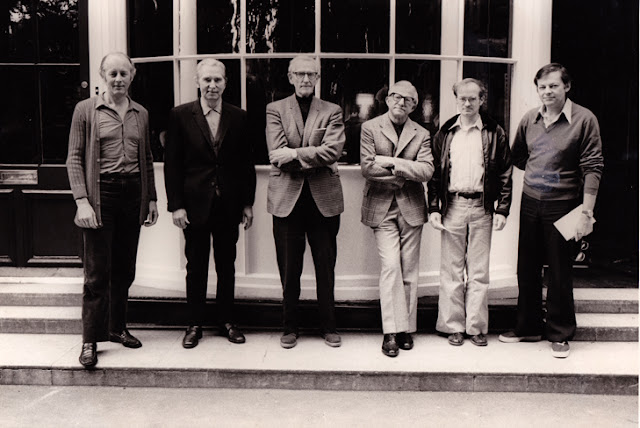 |
| Art Babbitt at Soho Square in the 1970s. Art is 3rd from the right, flanked by Grim Natwick to his left and Richard Purdum to his right |
By leading the strike, or, rather, by being one of the leaders of the strike (Art always insisted he was not the only one), Art effectively ended his career at Disney. US Labor laws meant that the studio was later forced to re-hire Babbitt - the case went all the way to the Supreme Court - but no law could force Disney to give Art anything interesting to do, so he sat in a room with no work until, bored and frustrated, he eventually left.
After Disney, Art become one of the founders of the legendary UPA studio, and worked on classic shorts such as Rooty-Toot-Toot, winning more and more awards. But by the 1970s work on shorts had dried up and my father found Art working on commercials, doing breakfast cereal ads for kids. So Dad brought him to his studio in London, and set him up as a kind of artist and teacher in residence, training the young animators in Hollywood techniques.
 |
| Art Babbitt and others outside no 13 Soho Square. Second from left is Grim Natwick, creator of Betty Boop. |
I have a dog-eared copy myself on my shelf, which I used to pore over, searching for golden nuggets of insight that would transform my work. Art's classes would eventually form the nucleus of material that, much later - decades later - would inform Dad's authoritative book: The Animator's Survival Kit.
 |
| Art and Dad in Soho Square in the 1970s |
Around this time, in the mid 1980's, Dad and Mo (my stepmother) made a documentary film about Art and his work. It was called Animating Art (of course!) and it was broadcast on British TV in 1987. It is an excellent film, a very thoughtful journey into Art's life's work. A better documentary about what it means to be an animator would be hard to find.
Art worked a great deal on The Thief and The Cobbler. He did lots of the animation on the character of King Nod, an old and sleepy patriarch, his best years behind him. A bit like Art himself really, whose powers declined even as he moved back to California and continued to work on scenes from The Thief. In the end, Dad kept him on the payroll just to keep him going - Art had never, it seemed, saved any money.
Years later, in 1990, when The Thief went into full production, I inherited many of Art's shots to tidy up. His animation was still superb, and even his later work, where his drawing had declined, his sense of timing and spacing was still spot on. So a trainee animator like me could still transform the work into a great scene, just by cleaning up the key poses, and filling in the gaps.
Art died in 1992, the same year tha The Thief was due to be finished.
---Alex

I love these stories Alex! Art is a legend and its a shame younger folks don't know about him ot his beautiful work. This will help!
ReplyDelete